Creative Distractions #5
June-ary, Pika Watching, Garden Distractions, Herbal Tea Recipes, Seeing Differently, & An Unkindness of Ravens
Creative Distractions are a good thing. They could be essays, books, multimedia, music, films, poems, art, or other creative work that has touched or inspired me. I find an abundance of beautiful, thoughtful, humorous, and heartwarming examples of creativity every day.
This month’s Creative Distractions celebrates nature's creativity: colors, textures, shapes, seasons, cycles, relationships, botanical design, and sensory delight that inspire and awe.
June-ary in the PNW
While much of the US is experiencing an early summer heat wave, folks in the PNW are still wearing fleece jackets and beanies. In the Columbia River Gorge, nature added some wild winds to some cool days, forcing me to wrap my wool scarf around my neck to stay warm on my daily walk. Some years, June shows up in the PNW as unseasonably cool, cloudy, and rainy, and we mumble about an extension of January, nicknaming it June-ary. I might have been overheard complaining about the cool conditions, but it would have been far worse if I lived in heat and humidity.
Pika Watch Community Science Project
I completed my training for the Cascades Pika Watch in mid-May. Then, I headed to my first site to practice what I had learned with professional wildlife photographer and long-time volunteer Pika Watcher, Linda Steider. American pikas are adorable rabbit family members, about the size of a baking potato, and do not have a tail.
They prefer talus landscapes—broken rocks that form tall mounds and fields—at high elevations in mountain ranges, except for the Columbia River Gorge pikas, the only low-elevation population in the US. I heard but did not see any pikas on my first outing.
This community science project was started over a decade ago, and each spring and summer, hundreds of volunteers visit designated sites in the Gorge, sit, listen, and look for pikas. Each volunteer records their visit and findings to a database. This project has already demonstrated its usefulness after the large Eagle Creek wildfire impacted the pika population, and volunteers’ data over the following years showed their return. Check out Linda’s collection of pika photos on her website, Steider Studios.
Garden Busyness
We have had enough warm days to offer hope for an eventual summer, and vegetable growers like me are often hopeful risk-takers. Despite 35 years of PNW gardening experience and wisdom, I let optimism rule my decision-making and transplanted tomato, tomatillo, and melon seedlings in mid-May during a week when the warm weather Trickster was in town.
Several weeks later, I lost all of them to overnight frost. Fortunately, I live in a region with a robust local food economy, and I can buy boxes of tomatoes to process for winter preservation. The cool and cloudy weather did not bother the weeds, and I have been selectively weeding. Some weeds offer medicine, protect the soil by covering it, and attract pollinators. I am thankful for the technology of cell phones, audiobooks, and podcasts, which keep me company while I am weeding, shoveling, and planting.
Current Garden Status:
A few weeks ago, I clipped the garlic scapes (flower stalks of hard-neck garlic)) and made garlic scape pesto. The October-planted garlic will be harvested in mid-July, and that bed will be planted with veggie transplants for fall harvest.
Brussels sprouts (a biennial) from last year's garden have flowered early, delighting the bees, and have now set seed. I will have plenty of seeds to save and donate to the community seed library I started three years ago.
Another bed hosts last year’s leeks (also a biennial), which are now flowering, and I am hopeful for a bounty of seeds.
The strawberries and rhubarb are growing but not abundantly; I planned to move them into a new bed with better soil before they started, but it didn’t happen.
The spring-planted potatoes, onions, and leeks are doing beautifully. The divas of the vegetable world - cucumbers, peppers, and summer and winter squash - patiently wait for warmer weather to grow their leaves and fruits.
The mustards I am trialing for Seed Savers Exchange are doing well, but the carrots I am trialing have poor germination rates. I may have sowed them too deeply or they rotted in the soaked soil.
I accidentally left the cover open on my early spring salad bed, and the rabbits devoured my lettuce and spinach in one night. That worked out well for them and for the local farmers from whom I am now buying my greens.
I have been harvesting and drying the flowers of wild roses, elderberry, yarrow, and red clover. I use these to make herbal tea blends.
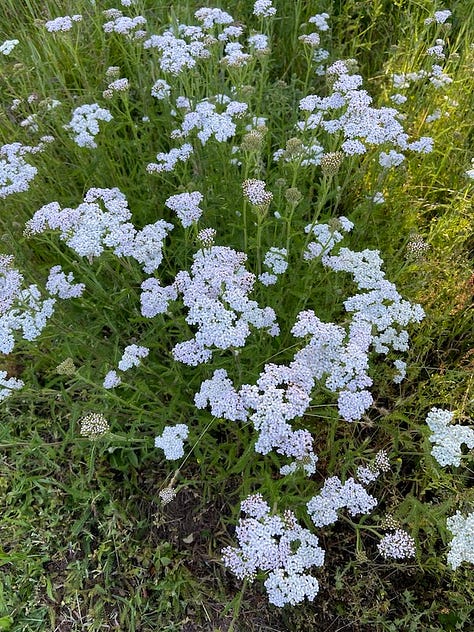

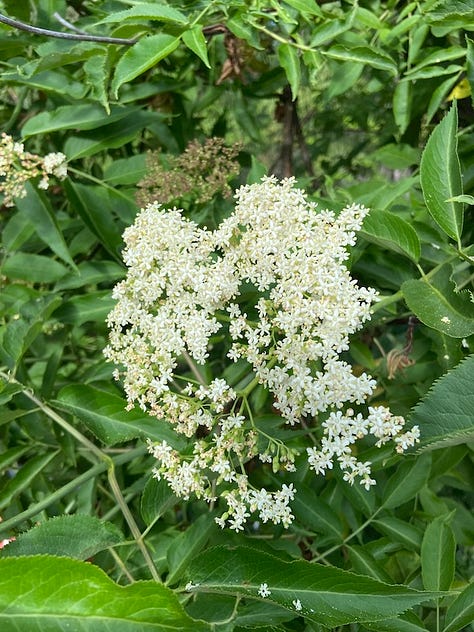
Recipe: Cold Care Tea
1 part dried elder flowers, 1 part dried yarrow flowers, 1 part dried peppermint (I sometimes add a few dried rose hips and a pinch of dried ginger)
This tea relieves nasal congestion, reduces fever, and supports immune system response. It may cause perspiration. Traditional Medicinals make and sell this tea in many grocery stores.
Recipe: Cacao & Wild Rose Tea
1 part cacao nibs, 1 part dried rose petals/buds, 1/2 part black tea, a small splash of vanilla extract
It's such a simple tea, but the taste is so complex. Perfect for a cool autumn night.
Look Closer: New Ways of Seeing
I attended the Washington Native Plant Society’s (WNPS) annual conference, which was held in Sequim on the northern coast of the Olympic Penisula. Sequim is in the Olympic mountains' rain shadow, so it markets itself as “Sunny Sequim.” But PNW plant nerds aren’t fooled by such marketing propaganda, so we packed for four seasons. It was cloudy, rainy, and cold; for those who hiked into the mountains to spy on native wildflowers, it snowed. The sun and warmer weather showed up the day after the conference ended.
I attended a seaweed workshop on Friday, went on a botanical walk in an iconic PNW forest on Saturday, and crawled through moss and liverwort on Sunday morning. Each activity taught me fascinating information, but what I gained the most was the opportunity to look closer and see the intricacies of nature.
Seaweeds - The presenter was so enthusiastic that I left loving seaweed! A former scientific diver (I didn’t know that was a career), he now works for Washington Fish & Wildlife as a permit coordinator. Seaweed harvesting is a carefully regulated commercial industry in WA, including seaweed farms and wild harvesting. His presentation included fresh samples he collected the night before and many prints of seaweed species. It was a new way to see the plants that most of us only see washed up on the beach. Or in sushi.



Forest Walk - Our small group of four was led by a botanist and long-time volunteer with WNPS. Dark clouds threatened and delivered a short but heavy shower as soon as we left our cars. There is a saying in the PNW: if you wait for good weather to go outside, you’ll spend a lot of time inside. Rain gear on, we headed to the trail. I love PNW forests and can identify many plants, but hiking with an engaging botanist can offer a new way of seeing. Rhododendrons, the state flower of Washington, were in bloom, and our guide stopped to show us the poricidal anthers on their flowers. Poricidal anthers have tiny holes at their tips, which are specialized mechanisms for pollen release, and pollinators have evolved specialized behaviors to access the pollen. With a hand lens and eye loupes, we tried to see the tiny holes at the tip of the anthers several times along the trail, but no luck. Our guide was now determined to find visible holes, and at the end of the hike, we finally found poricidal anthers with their holes open. A day of forest bathing did my heart good.
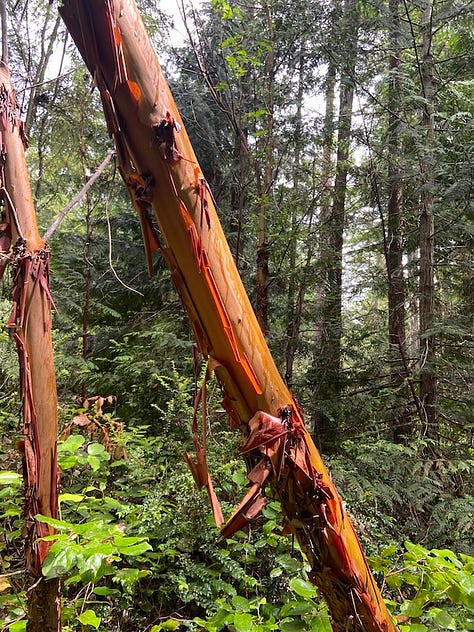

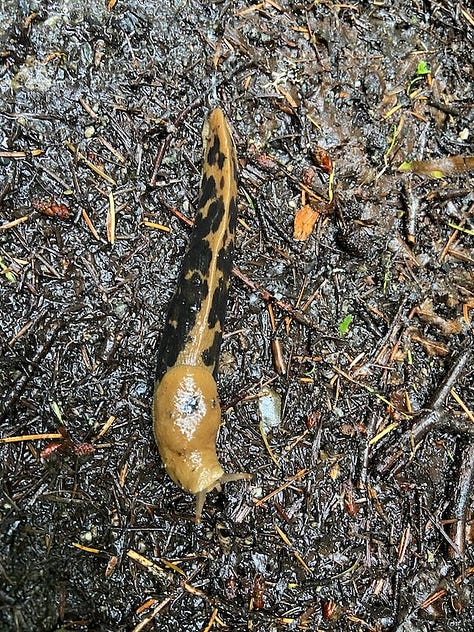
Mosses & Liverworts - In the February newsletter, Seeking the Holy, I mentioned that I wanted to learn more about mosses. I immediately signed up for this activity when I registered for the conference. The guide was a textile artist who studied mosses after reading Robin Wall Kimmerer’s first book, Gathering Moss. Mosses and liverworts are some of the oldest species on the planet and have some unique characteristics. Robin Wall Kimmerer is a bryologist - a moss scientist - and her book is full of essays on mosses. I am sharing two recorded presentations on mosses and liverworts that our guide did for a local land trust.
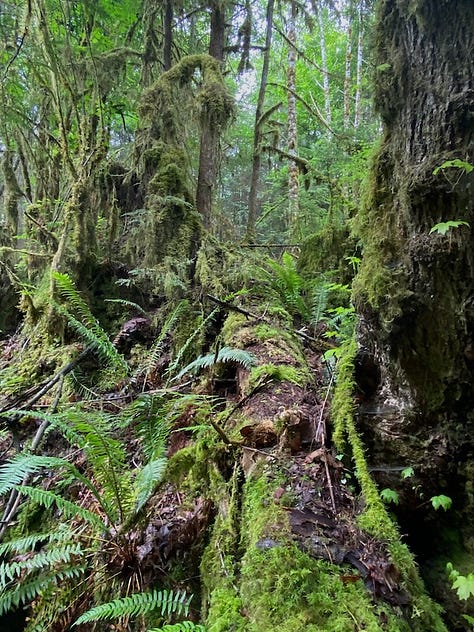

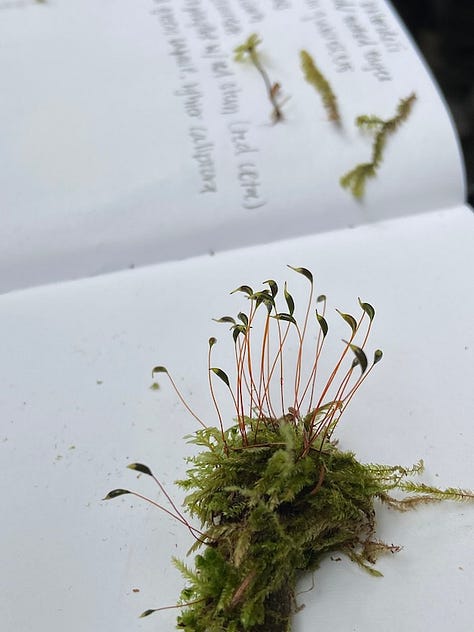
Moss talk with Jefferson Land Trust:
LIverworts talk with JLT:
National Wildlife Refuge Stroll
I stayed an extra day in Sequim and visited the nearby Dungeness National Wildlife Refuge, one of the world’s longest natural sand spits. It is situated on the calm waters of the Strait of Juan de Fuca and is a haven for many migrating shorebirds, young salmon, and harbor seals and their pups. I was a bit late for all of those animals, but I walked several miles on the beach before turning around because the tide was coming in.
An Unkindness of Ravens
I have been working in the garden in the early mornings, and the birdsong is a lovely distraction. Last week, I listened to a flock of ravens cawing non-stop. I couldn’t see them the first day until they flew over me. They were at it again the next morning, and I watched as they flew in and out of the Ponderosa pines that line my gravel road. I didn’t understand what they were doing, so I observed and researched.
The young ravens, likely supervised by their mated parents, seemed to be playing and exploring. Juvenile ravens love to play and are incredibly curious. In Bernd Heinrich’s book The Mind of the Raven, he observed his tamed ravens pick up everything new they came across while walking along a path. My small group was flying low, in and out of the trees and dropping down to the road while other ravens perched in the trees.
Here are a few things I learned:
The collective noun for a flock of ravens is unkindness or a conspiracy, and a flock of crows is called a murder. These dark terms were likely assigned because of the superstitions and lore that Corvids have endured for centuries. In the PNW, ravens play the role of tricksters/jokers in indigenous myths.
Ravens are called “wolfbirds” because they have a symbiotic relationship with wolves. They follow the predators and eat the remains of their kills.
Ravens are known for their aerobatics: they soar on currents, tuck their wings in to dive, roll in flight, and drop and retrieve objects in the air.
Ravens & crows are known for their intelligence and have been observed working together and using objects like sticks to solve problems.
Thank you for being here. If you’d like to support my work, you can do so by:
1) Liking and restacking this post so others are encouraged to read it.
2) Sharing this post via email or on social media.
3) Upgrade your subscription for as little as $5 per month.
Nature is full of creative distractions! Your comments are always welcome.






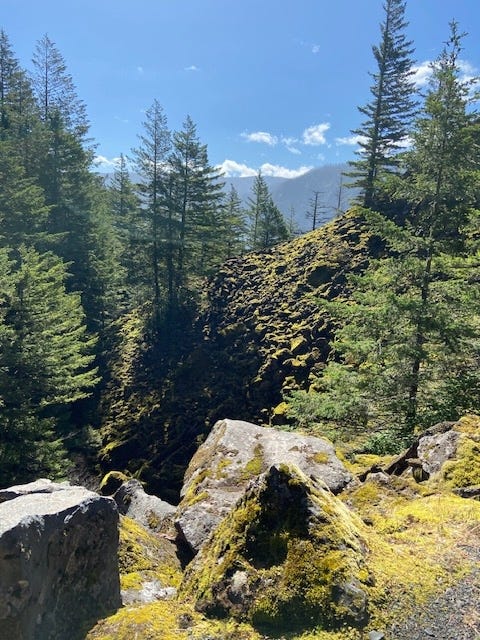

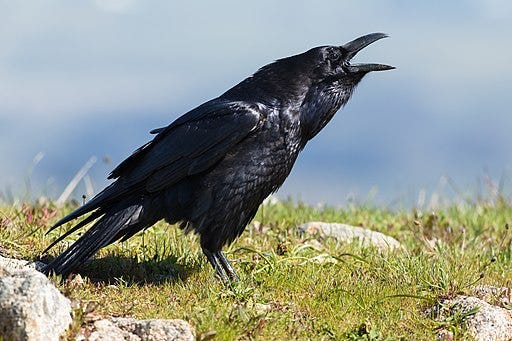
There is so much here! I learned a new word "poricidal" as well as about anthers with holes in their tips. Fascinating! How interesting the conference was, and all of your experiences there. Ravens are fun to watch flying; they are quite acrobatic. Mesmerizing. Making your own tea must be fun and rewarding, and the pikas! They are adorable. I have seen them in the peaks in SW Montana. Such industrious little fellows. Thank you for all of this!
So important to think about what we have done and noticed as a way to have better recollection of the good times!
As a long time PNW gardener-wannabe, I skip all of the hot weather thrivers like tomatoes and cukes unless I get a good buy on a well started potted plant. Occasionally I have had cherry tomatoes do quite well. The good part of this, is that I love greens of all kind and winter squash, zucchinis, beans and peas and that is enough work for me! My father had a trick of growing beef steak tomatoes on the south facing wall of his workshop. He attached a clear sheet of plastic above the plants and would roll it up and down each day in the fall to keep those plants producing well into November! I miss those fresh Thanksgiving tomatoes! 😄 I now do something like this with 1/4 in wire screen to protect some plants from the deer, rabbits and other nibblers.